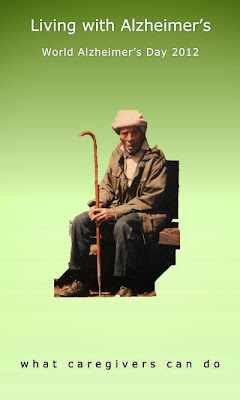Caregivers living with persons having Alzheimer's Disease face specific problem behaviours. These behavioural problems result from memory loss that is the hallmark symptom of Alzheimer's. We have previously discussed resources giving hope for dementia caregivers. Caregiver do's and dont's for mental illnesses in general have also been highlighted. Living with Alzheimer's Disease is the theme for World Alzheimer's Day 2012. In this post we specify methods to help caregivers living with persons having Alzheimer's handle problems related to memory loss and reduce the burden of care at home.
Caregiver techniques for Alzheimer's
- Regular routine enables basic activities of daily living for a longer period of time. Make a visual time-table and regularly remind the person with Alzheimers to consult it so it becomes a habit.
- Keep large clocks in each room and remind them of the time at every opportunity.
- A personalised calendar with large figures helps plan and anticipate potentially confusing events such as a festival or travel.
- A room with a window is great for orientation. Natural daylight and dark phases maintain the sleep-wake cycle.
- Greet at every new meeting with date and time. The date is particularly difficult for a person with Alzheimer's to learn - it changes every day - hence the disorientation. Repetition will keep the person with Alzheimers disease current with the month and year for longer.
- Keep familiar objects like photos, phone, books, and decorative pieces in the same place. People with Alzheimer's often have to move from one set of caregivers to another. Placing these objects in the same general positions helps them to avoid confusion and anxiety.
- Photographs are important visual memory pegs. Two or three frames with photographs of the caregiver families and old friends reassures the person with Alzheimer's disease and facilitates their smooth transition between caregivers.
- An identity card is essential for every person with Alzheimer's. It must contain an address and an emergency contact number. It should be worn at all times, even inside the house. Your loved one can wander out of an open door and not be able to find her way back. Reinforce and rehearse showing or consulting the identity card on being asked for address or phone number.
- Encourage and let them do the things they can. Don't take over every activity or your caregiver burden will increase. Prompt them when they hesitate or take time. Help them in those activities they are unable to do.


